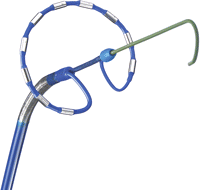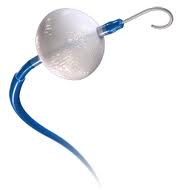
There is more bad news for the newest atrial fibrillation ablation tool–Medtronic’s Ablation Frontiers catheter-ablation system. After an overly positive press release last month, I wrote about the system’s safety issues.
Namely, that although effective, the multi-electrode PVAC circular ablation catheter was associated with an increased risk of stroke. Previous studies on the catheter showed much higher rates of new lesions on brain scans after AF-ablation. The problem in a nutshell is that the catheter allows clots to form on its electrodes. And these clots can travel northward to the brain.
Two weeks ago, as reported on TheHeart.org, an FDA panel recommended (9-1) against approval of the device, because of these safety concerns.
Now it looks like stroke concerns are only one problem with PVAC; the other is pulmonary vein stenosis—a dreaded complication of AF ablation. Ablation within the orifice of the pulmonary veins may cause damage that later obstructs blood flow out of the lungs.
In this published-before-print version of the journal, Circulation Arrhythmia and Electrophysiology, Belgian researchers showed striking increases in PV stenosis risk in 50 patients that underwent ablation with the PVAC catheter. They report:
- Moderate PV narrowing occurred in 78% of patients;
- Severe narrowing occurred in 15% of patients.
Not good.
The search to make AF ablation easier—and safer—continues.
AF ablation is clearly in a plateau phase of technology.
 Big, bulky cryo-ablation balloons don’t look to be revolutionary either. Think long learning curves, stiff sheaths and expensive capital investments.
Big, bulky cryo-ablation balloons don’t look to be revolutionary either. Think long learning curves, stiff sheaths and expensive capital investments.
Ablating AF is as it has been for years now. Successful outcomes are dependent on skilled human operators whose neural pathways have been honed after much experience. And of course it isn’t just skill moving a catheter; it’s the judgment to select patients most apt to respond to such an aggressive therapy.
Alas…it’s the human stuff!
Though I look forward to technology that makes AF ablation easier, safer and more effective, I revel in the impermanent ownership of at least one somewhat novel skill set.
JMM
5 replies on “Attempts to make AF ablation easier foiled by safety concerns”
How are patients recruited for these trials? What happens to the individuals who had bad outcomes? Is there a bucket of money set aside to provide care for the people who stroked out, or have the stenosis and can no longer make it to the grocery store? I always wonder who would volunteer for an unproven technology, and then what happens to them afterwards.
Clinical trials are necessary to advance medical care. Typically, medical devices like PVAC or CryoBalloons are investigated in animal models before human studies.
Whether it is a drug, device or catheter, patients enrolled in clinical trials take an informed risk. They balance the benefit of the ‘new’ treatment versus its unknown risk and benefit. Cancer drugs are studied in the same way.
In fact, one of the difficulties in enrolling patients in trials is that they often do not consent because of the chance of NOT getting the new treatment. The CABANA trial–an investigation of AF ablation versus drugs–is having such difficulty: patients with symptomatic AF want the ablation, not drugs.
As someone who has had two catheter ablations I find it interesting that there is so much excitement over “new and improved” methods and then the follow up on the down side – in this case risk of stroke is very hard to FIND – what do the Cardio/EP’s think of this? do THEY get caught up in the excitment of the moment at the prospect of a “new tool” or technique, WHO is it exactly that decides what is used – the Dr’s or do they get “told”?
For me the frustrating part after my 2nd ablation has been getting acknowledgement of the stroke that occured during mine – the Dr did his BEST to CONvince me that nothing happened and that the Neuro was “wrong” in identifying an abnormality on my MRI that tied in with my symptoms. When Dr’s are reluctant to admit or acknowledge that a problem has happened it is very upsetting to the patient more so than the fact that it happened – its like shhh! you don’t know what you are talking about! go away with your silly questions! stop bothering me!
Sue x
Someday the engineers and biotechnologists might have to admit that not everything can be broken down to 1’s and 0’s. I had a parent watch me as I did an orthodontic adjustment on their child’s braces. His comment was “You do it all with your hands!” It’s kinda nice knowing that you won’t be replaced by a robot any time soon or that attempts to dumb down procedures so that anybody can do it fail occasionally. Just like keeping it upright on a muddy off camber section, experience counts. BTW, I won a Cross race last weekend, two months post ablation.
Steve
Medtronic sucessfully lobbied to get themselves into a congressionally approved non-liability status regarding certain ICDs, in 2010 I think. Believe it was a 2-lead ICD. I find this deeply ominous on so many levels.